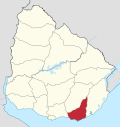
Punta del Este is a seaside city and peninsula on the Atlantic Coast in the Maldonado Department of southeastern Uruguay. Starting as a small town, Punta del Este later became internationally known as a resort for the Latin and North American jet set and tourists. The city has been referred to as "the Monaco of the South", "The Pearl of the Atlantic", "the Hamptons of South America","the Miami Beach of South America", or "the St. Tropez of South America".
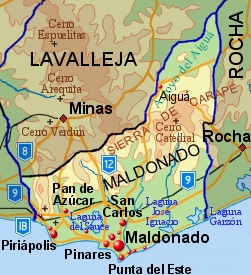
The Maldonado Department, with an area of 4,793 km2 (1,851 sq mi) and 164,300 inhabitants (2011), is located to the southeast of Uruguay. Its capital is Maldonado.

Pan de Azúcar is a city in the southwest of the Maldonado Department in Uruguay. It takes its name from a nearby hill, topped by a huge cross.

Maldonado is the capital of Maldonado Department of Uruguay. As of the census of 2021, it is the ninth most populated city in the country.

Punta Colorada is a small peninsula and a resort in the Maldonado Department of Uruguay.
La Floresta is a city and resort on the Costa de Oro of the Canelones Department in Uruguay.
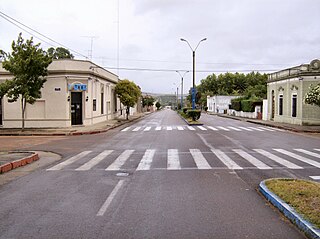
Aiguá is a city of the Maldonado Department in Uruguay. Its name means running water in the Guaraní language. It is also the name of the municipality to which the city belongs. It includes the following zones: Aiguá, Sauce de Aiguá, Sarandí de Aiguá, Alférez, Valdivia, Salamanca, Coronilla, Rincón de Aparicio, Los Talas, Paso de los Talas.

Tourism in Uruguay is an important part of the nation's economy.

Cerro Pan de Azúcar is among the top 10 highest points of Uruguay, with an altitude of 423 metres (1,387.8 ft).
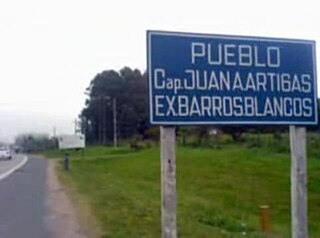
Barros Blancos is a city in the Canelones Department of southern Uruguay. In 1976, it had been renamed to Juan Antonio Artigas, after commanding officer Juan Antonio Artigas, grandfather of the national hero José Gervasio Artigas, but the old name was reinstated in 2007.

Garzón is a village in the Maldonado Department of southeastern Uruguay.

Route 10 is a national route of Uruguay. In 1983, it was assigned the name Juan Díaz de Solís, honouring the Spanish navigator.

Ruta Interbalnearia or Ruta Líber Seregni is a national route of Uruguay. It connects Montevideo with Punta del Este to the east along the coast. The road is approximately 90 kilometres (56 mi) in length. It is marked on maps and signs as IB.
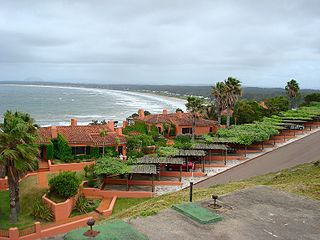
Punta Ballena is a small peninsula (punta) and a resort (balneario), as well as an important tourist attraction on the coast of Río de la Plata in the Maldonado Department of southeastern Uruguay. It comprises an approximately 12 kilometres (7.5 mi) long stripe of beaches and landforms and extends on both sides of Route 10.

Punta Negra is a small peninsula (punta) and a resort (balneario) in the Maldonado Department of Uruguay.
Sauce de Portezuelo is a resort (balneario) in the Maldonado Department of Uruguay.

Chihuahua is a resort (balneario) in the Maldonado Department of Uruguay.
Ocean Park is a resort (balneario) in the Maldonado Department of Uruguay.
La Estación de cría y fauna autóctona Cerro Pan de Azúcar is a nature park and zoo located close to the coastal city of Piriápolis in the Department of Maldonado, in southeastern Uruguay. The park belongs to the Municipal Administration Department of Maldonado. Some 250 examples of 53 species of Uruguayan animals are housed within an area of 86 hectares, surrounded by native trees and bushes. 300,000 people visit the park annually, many of which are groups of students.

The Municipality of Maldonado is one of the eight municipalities of Maldonado Department, Uruguay. It was created by Law N° 18653 of 15 March 2010.
























